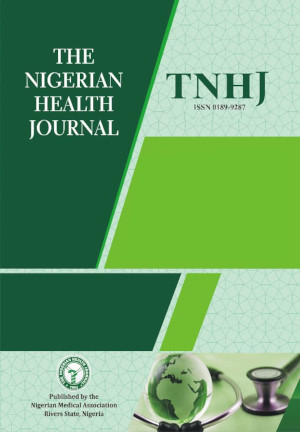Upper Gastro-Intestinal Endoscopy in Port-Harcourt: An Audit
Keywords:
Upper gastro-intestinal tract, Endoscopy, AuditAbstract
Background: Accurate diagnosis of disease conditions using laboratory, imaging or endoscopic investigation is essential for appropriate treatment. Direct visualization of the gastro-intestinal (GI) tract by endoscopy additionally offers the benefit of biopsy and therapeutic options. An audit of our early experience with oesophagogastroduodenoscopy(OGD) is necessary to improve the quality of patient care and outcome.
Aims: To review the pattern of presentation and endoscopic findings of symptomatic upper gastro-intestinal disease conditions.
Patients and Method: All consecutive patients presenting to the endoscopy unit of a private hospital from February 2012 to July 2013 were prospectively studied. The socio-demographics, indications, endoscopic findings and histopathology report for biopsies were collated. Data was statistical analyzed using SPSS version 20.
Results: There were 30 OGDs in 25 patients performed during the study period. Fifteen were males and 10 females, a M: F ratio of 3:2 and age range from 17-81years (mean 44yrs SD 14.7).The indications included: epigastric pain (40%), dyspepsia (23%) and dysphagia (14%). Antral gastritis (21%) was the most common endoscopic findings and while more than one pathology was seen in 5(17%) cases.
Conclusion: Peptic ulcer is not the most common cause of epigastric pain. Antral gastritis and multiple non-ulcer pathologies are the more common conditions seen on OGD. This emphasizes the need for thorough endoscopic investigation in symptomatic upper GI disease.
Downloads
Published
How to Cite
Issue
Section
License
Copyright (c) 2015 The Nigerian Health Journal

This work is licensed under a Creative Commons Attribution-NonCommercial-NoDerivatives 4.0 International License.
The Journal is owned, published and copyrighted by the Nigerian Medical Association, River state Branch. The copyright of papers published are vested in the journal and the publisher. In line with our open access policy and the Creative Commons Attribution License policy authors are allowed to share their work with an acknowledgement of the work's authorship and initial publication in this journal.
This is an open access journal which means that all content is freely available without charge to the user or his/her institution. Users are allowed to read, download, copy, distribute, print, search, or link to the full texts of the articles in this journal without asking prior permission from the publisher or the author.
The use of general descriptive names, trade names, trademarks, and so forth in this publication, even if not specifically identified, does not imply that these names are not protected by the relevant laws and regulations. While the advice and information in this journal are believed to be true and accurate on the date of its going to press, neither the authors, the editors, nor the publisher can accept any legal responsibility for any errors or omissions that may be made. The publisher makes no warranty, express or implied, with respect to the material contained herein.
TNHJ also supports open access archiving of articles published in the journal after three months of publication. Authors are permitted and encouraged to post their work online (e.g, in institutional repositories or on their website) within the stated period, as it can lead to productive exchanges, as well as earlier and greater citation of published work (See The Effect of Open Access). All requests for permission for open access archiving outside this period should be sent to the editor via email to editor@tnhjph.com.



